A Substrate Integrated Waveguide Resonator Sensor for Dual-Band Complex Permittivity Measurement
Abstract
:1. Introduction
2. Measurement Method and Setup
2.1. Structure of the Proposed Sensor
2.2. Electric Field Distribution of the Proposed Sensor
2.3. Measured and Simulated Results of the Proposed Sensor
3. Extraction of Permittivities
3.1. Measurements of the Sensor Resonant Frequency and Quality Factor
3.2. Diagram of the BP-ANN Algorithm
3.3. Reconstruction of Material Permittivity by the BP-ANN Algorithm
4. Experimental Results
4.1. Measurement Process with the Proposed Sensor
4.2. Measurement Results with the Proposed Sensor
5. Conclusions
Author Contributions
Funding
Institutional Review Board Statement
Informed Consent Statement
Data Availability Statement
Conflicts of Interest
References
- Zhang, H.; Zeng, B.; Ao, L.; Zhang, W.; Li, N.; Guo, J. Printed four arcs coupler in cylindrical cavity for permittivity measurement. Electron. Lett. 2012, 48, 1460–1462. [Google Scholar] [CrossRef]
- Cheng, G. Calibration-independent measurement of complex permittivity of liquids using a coaxial transmission line. Rev. Sci. Instrum. 2015, 86, 014704. [Google Scholar]
- Shaforost, E.N.; Klein, N.; Vitusevich, S.A.; Barannik, A.A.; Cherpak, N.T. High sensitivity microwave characterization of organic molecule solutions of nanoliter volume. Appl. Phys. Lett. 2009, 94, 112901. [Google Scholar] [CrossRef]
- Su, L.; Mata-Contreras, J.; Vélez, P.V.; Fernández-Prieto, A.; Martín, F. Analytical method to estimate the complex permittivity of oil samples. Sensors 2018, 18, 984. [Google Scholar] [CrossRef] [PubMed] [Green Version]
- Booth, J.C.; Orloff, N.; Mateu, J.; Janezic, M.; Rinehart, M.; Beall, J.A. Quantitative Permittivity Measurements of Nanoliter Liquid Volumes in Microfluidic Channels to 40 GHz. IEEE Trans. Instrum. Meas. 2010, 59, 3279–3288. [Google Scholar] [CrossRef]
- Nyshadham, A.; Sibbald, C.L.; Stuchly, S.S. Permittivity Measurements using Open-Ended Sensors and Reference Liquid Calibration—An Uncertainty Analysis. IEEE Trans. Microw. Theory Tech. 1992, 40, 305–314. [Google Scholar] [CrossRef]
- Kaatze, U.; Feldman, Y. Broadband dielectric spectrometry of liquids and biosystems. Meas. Sci. Technol. 2005, 17, R17–R35. [Google Scholar] [CrossRef]
- Anon. Reaction Mechanisms. 2021. Available online: https://chem.libretexts.org/@go/page/1417 (accessed on 23 February 2022).
- Wille, U. Reaction mechanisms: Radical and radical ion reactions. Annu. Rep. Prog. Chem. Sect. B Org. Chem. 2012, 108, 228–250. [Google Scholar] [CrossRef]
- Mohd Bahar, A.A.; Zakaria, Z.; Md Arshad, M.K.; Isa, A.A.M.; Dasril, Y.; Alahnomi, R.A. Real Time Microwave Biochemical Sensor Based on Circular SIW Approach for Aqueous Dielectric Detection. Sci. Rep. 2019, 9, 184–188. [Google Scholar] [CrossRef]
- Hong, J.S.; Vogt, S.; Schneider, M. Dielectric Permittivity Determination in W-Band with Dielectric Ring Resonators. In Proceedings of the 2016 German Microwave Conference (GeMiC), Bochum, Germany, 14–16 March 2016; pp. 453–456. [Google Scholar]
- Watts, C.; Hanham, S.M.; Ahmad, M.M.; Adabi, M.; Klein, N. Coupled dielectric-split ring microwave resonator for liquid measurements in microfluidic channels at nanoliter volumes. In Proceedings of the 46th European Microwave Conference (EuMC), London, UK, 4–6 October 2016; pp. 257–260. [Google Scholar]
- Bahar, A.M.; Zakaria, Z.; Isa, A.A.M.; Ruslan, E.; Alahnomi, R.A. Current developments of material characterization using microwave resonator based sensors: A review. Int. J. Appl. Eng. Res. 2015, 10, 34416–34419. [Google Scholar]
- Lee, C.S.; Yang, C.L. Complementary split-ring resonators for measuring dielectric constants and loss tangents. IEEE Microw. Wirel. Compon. Lett. 2014, 24, 563–565. [Google Scholar] [CrossRef]
- Chretiennot, T.; Dubuc, D.; Grenier, K. A Microwave and microfluidic planar resonator for efficient and accurate complex permittivity characterization of aqueous solutions. IEEE Trans. Microw. Theory Tech. 2013, 61, 972–978. [Google Scholar] [CrossRef] [Green Version]
- Boybay, M.S.; Ramahi, O.M. Material characterization using complementary split-ring resonators. IEEE Trans. Instrum. Meas. 2012, 61, 3039–3046. [Google Scholar] [CrossRef]
- Javed, A.; Arif, A.; Zubair, M.; Mehmood, M.Q.; Riaz, K. A Low-Cost Multiple Complementary Split-Ring Resonator Based Microwave Sensor for Contactless Dielectric Characterization of Liquids. IEEE Sens. 2020, 20, 11326–11334. [Google Scholar] [CrossRef]
- Iqbal, A.; Smida, A.; Saraereh, O.A.; Alsafasfeh, Q.H.; Mallat, N.K.; Lee, B.M. Cylindrical Dielectric Resonator Antenna-Based Sensors for Liquid Chemical Detection. Sensors 2019, 19, 1200. [Google Scholar] [CrossRef] [Green Version]
- Hao, H.; Wang, D.; Wang, Z. Design of Substrate-Integrated Waveguide Loading Multiple Complementary Open Resonant Rings (CSRRs) for Dielectric Constant Measurement. Sensors 2020, 20, 857. [Google Scholar] [CrossRef] [Green Version]
- Chuma, E.L.; Iano, Y.; Fontgalland, G.; Roger, L.L.B. Microwave Sensor for Liquid Dielectric Characterization Based on Metamaterial Complementary Split Ring Resonator. IEEE Sens. J. 2018, 18, 9978–9983. [Google Scholar] [CrossRef]
- Fesharaki, F.; Akyel, C.; Wu, K. Broadband permittivity measurement of dielectric materials using discontinuity in substrate integrated waveguide. Electron. Lett. 2013, 49, 194–196. [Google Scholar] [CrossRef]
- Loconsole, A.M.; Francione, V.V.; Portosi, V.; Losito, O.; Catalano, M.; di Nisio, A.; Attivissimo, F.; Prudenzano, F. Substrate-Integrated Waveguide Microwave Sensor for Water-in-Diesel Fuel Applications. Appl. Sci. 2021, 11, 10454. [Google Scholar] [CrossRef]
- Liu, C.; Tong, F. An SIW resonator sensor for liquid permittivity measurements at C band. IEEE Microw. Wirel. Compon. Lett. 2015, 25, 751–753. [Google Scholar]
- Zhou, H.; Hu, D.; Yang, C.; Chen, C.; Ji, J.; Chen, M.; Chen, Y.; Yang, Y.; Mu, X. Multi-Band Sensing for Dielectric Property of Chemicals Using Metamaterial Integrated Microfluidic Sensor. Sci. Rep. 2018, 8, 14801. [Google Scholar] [CrossRef] [Green Version]
- Chen, Q.; Huang, K.-M.; Yang, X.; Luo, M.; Zhu, H. An artificial nerve network realization in the measurement of material permittivity. Prog. Electromagn. Res. 2011, 116, 347–361. [Google Scholar] [CrossRef] [Green Version]
- Asteris, P.G.; Mokos, V.G. Concrete compressive strength using artificial neural networks. Neural Comput. Appl. 2020, 32, 11807–11826. [Google Scholar] [CrossRef]
- Li, S.; Wang, S.; Xie, D. Research on radar clutter recognition method based on LSTM. J. Eng. 2019, 19, 6247–6251. [Google Scholar]
- Chen, Q.; Huang, K.; Zeng, X.; Liu, C. Note: Coaxial apparatus to measure the permittivities of chemical solutions at microwave frequencies. Rev. Sci. Instrum. 2017, 88, 046102. [Google Scholar] [CrossRef]
- Meng, Z.; Wu, Z.; Gray, J. Microwave sensor technologies for food evaluation and analysis: Methods, challenges and solutions. Trans. Inst. Meas. Control 2018, 40, 3433–3448. [Google Scholar] [CrossRef] [Green Version]
- Xu, F.; Wu, K. Guided-wave and leakage characteristics of substrate integrated waveguide. IEEE Trans. Microw. Theory Tech. 2005, 53, 66–73. [Google Scholar]
- Kwok, R.; Liang, J.-F. Characterization of high-Q resonators for microwave filter applications. IEEE Trans. Microw. Theory Tech. 1999, 47, 111–114. [Google Scholar] [CrossRef]
- Sato, T.; Chiba, A.; Nozaki, R. Dynamical aspects of mixing schemes in ethanol–water mixtures in terms of the excess partial molar activation free energy enthalpy and entropy of the dielectric relaxation process. J. Chem. Phys. 1999, 110, 2508–2521. [Google Scholar] [CrossRef]
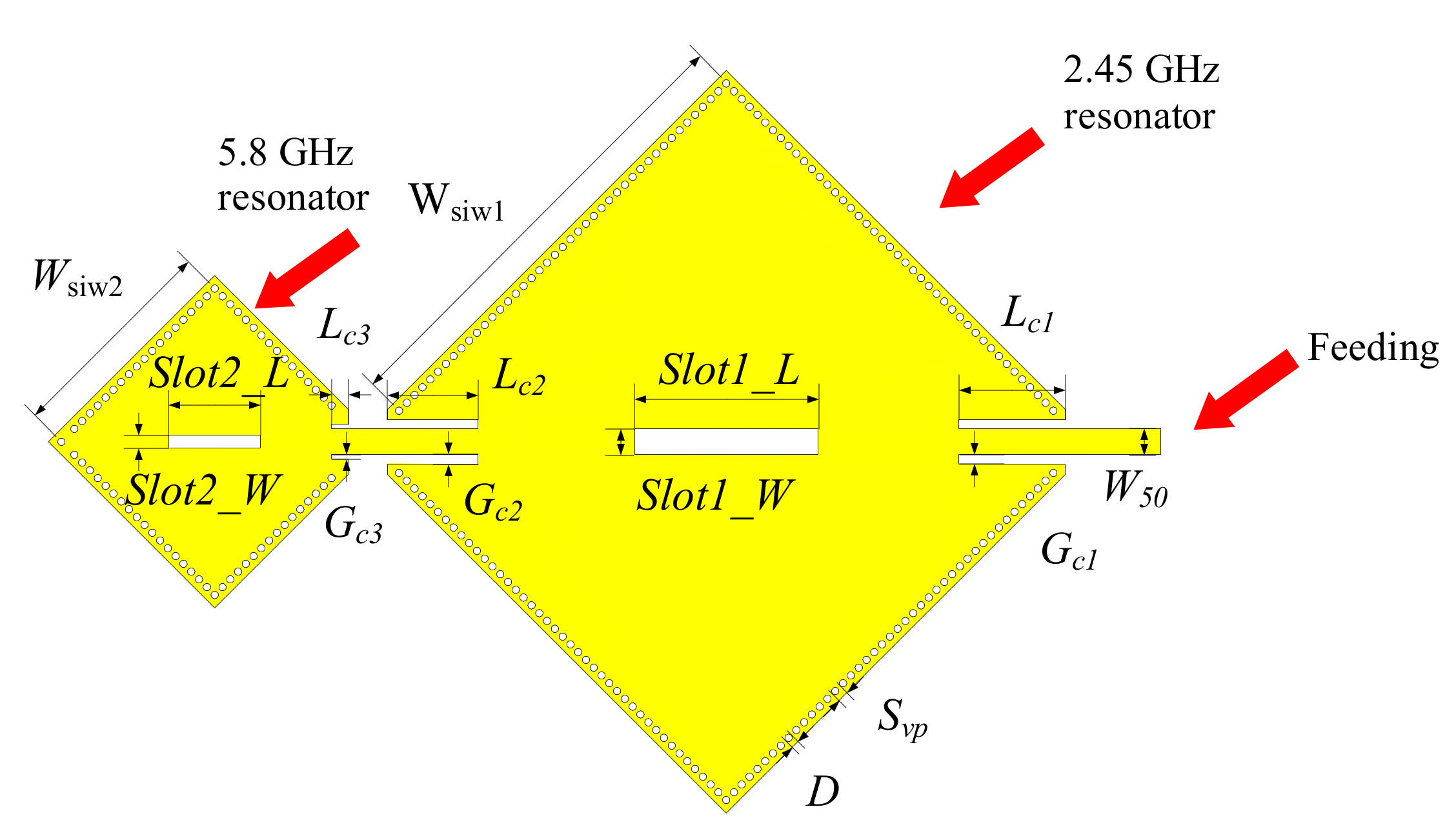
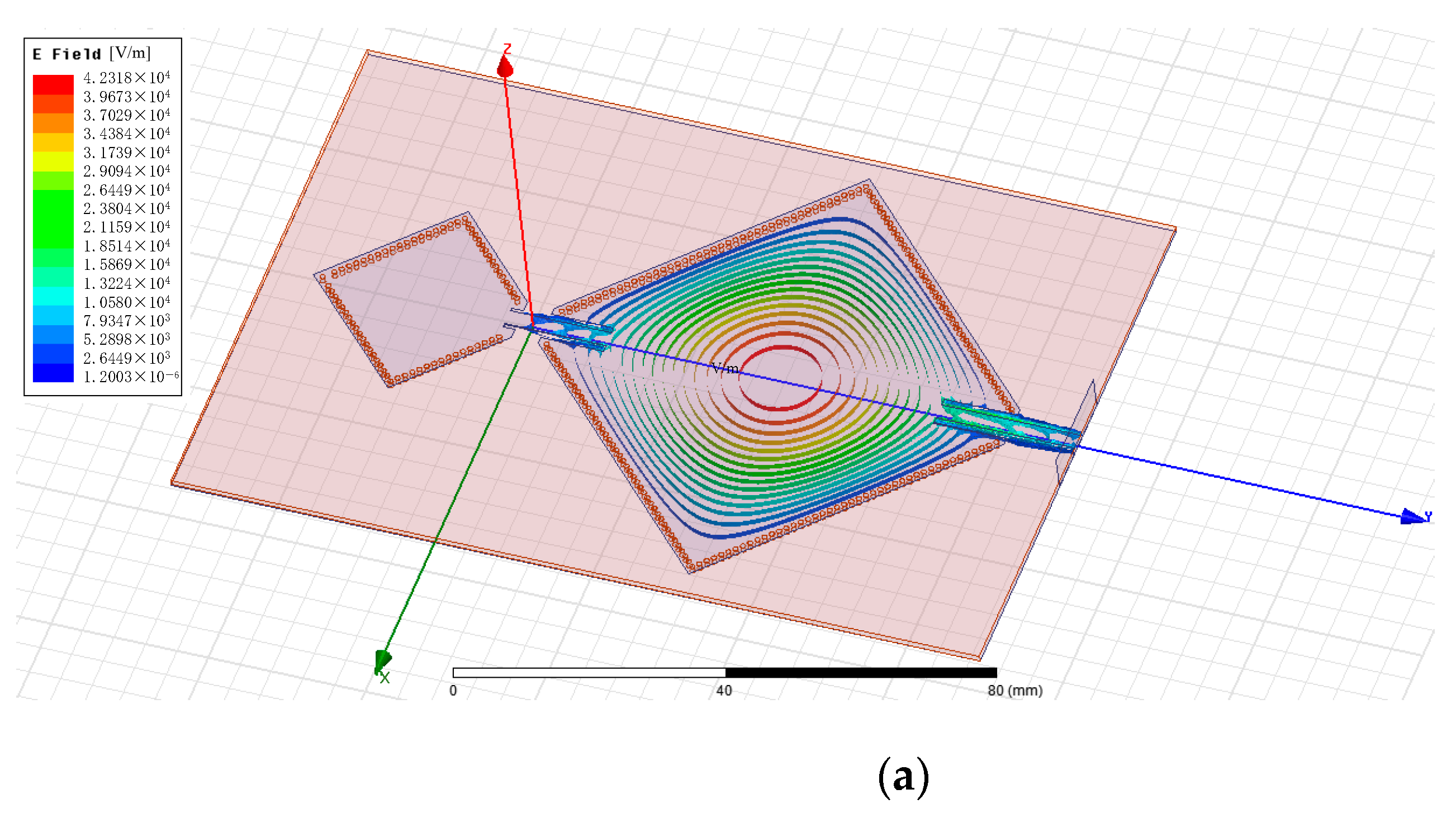

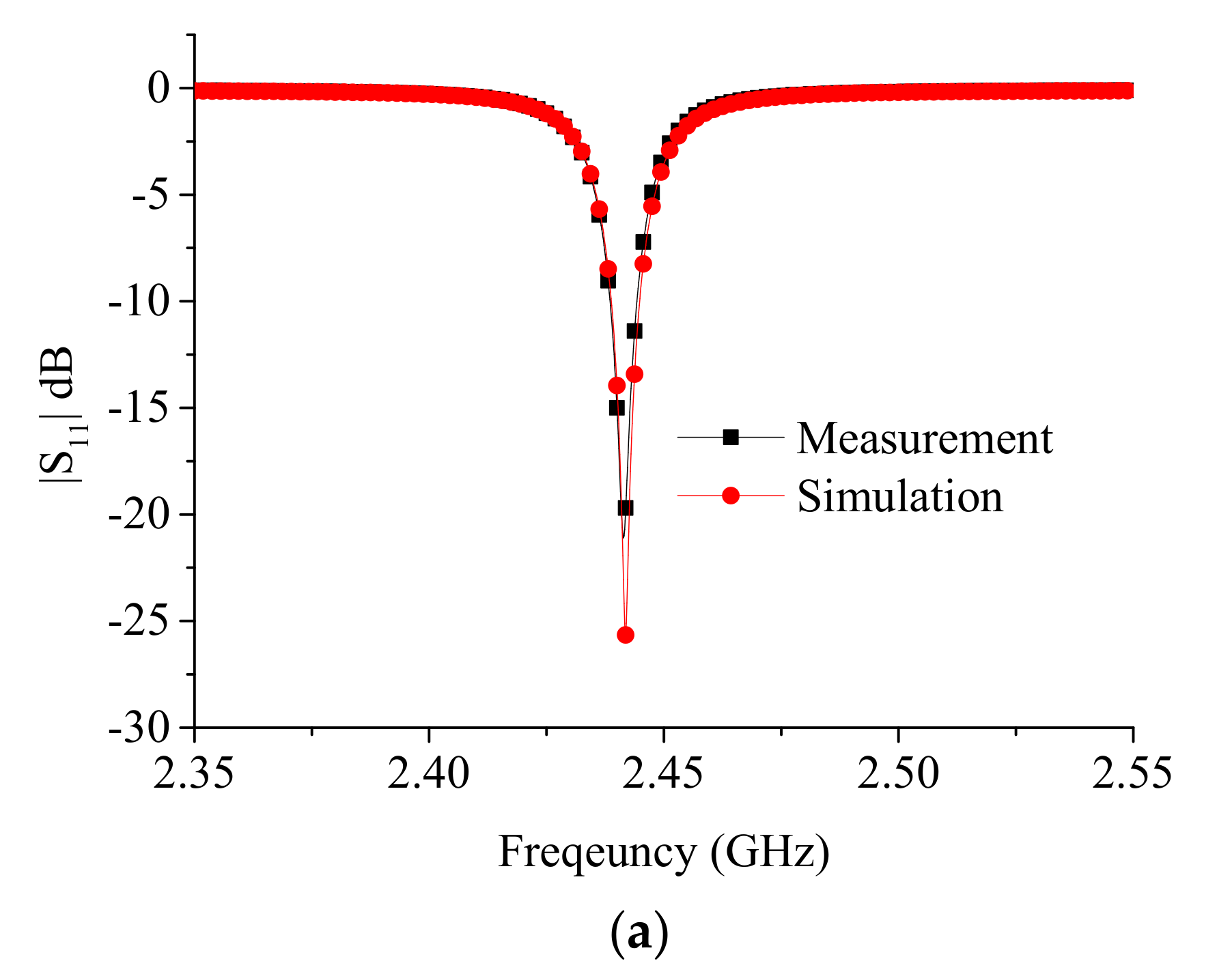

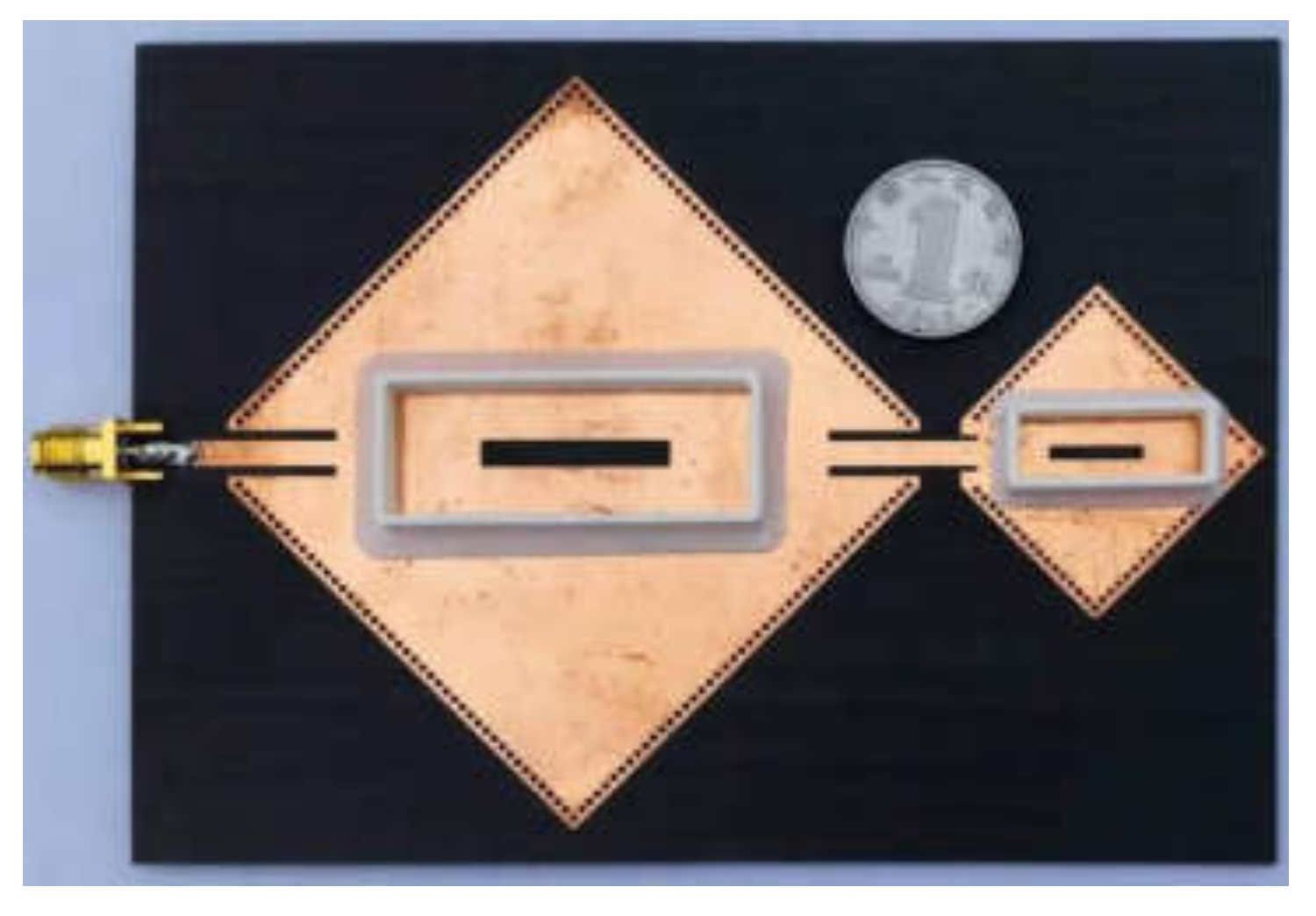
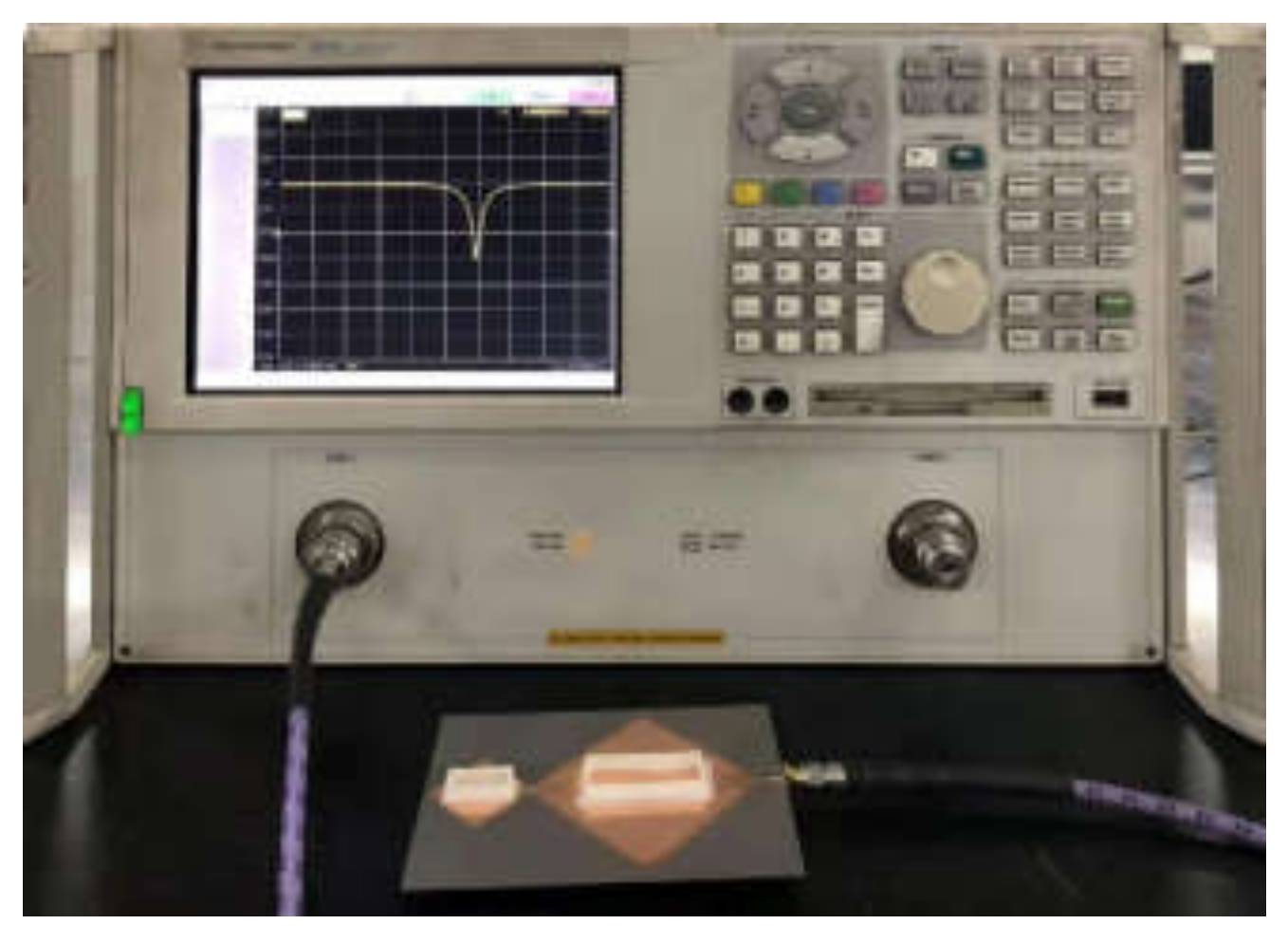
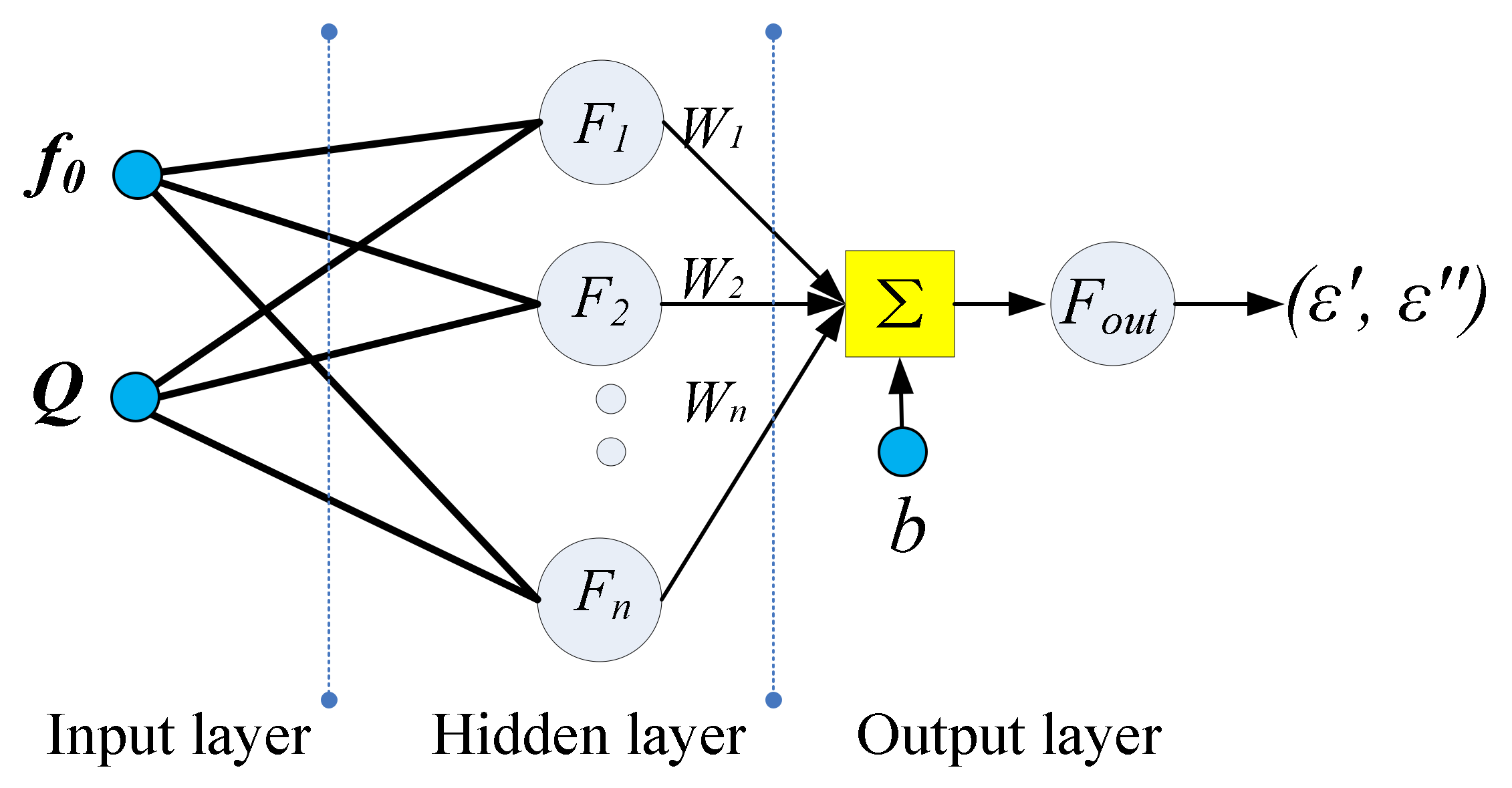
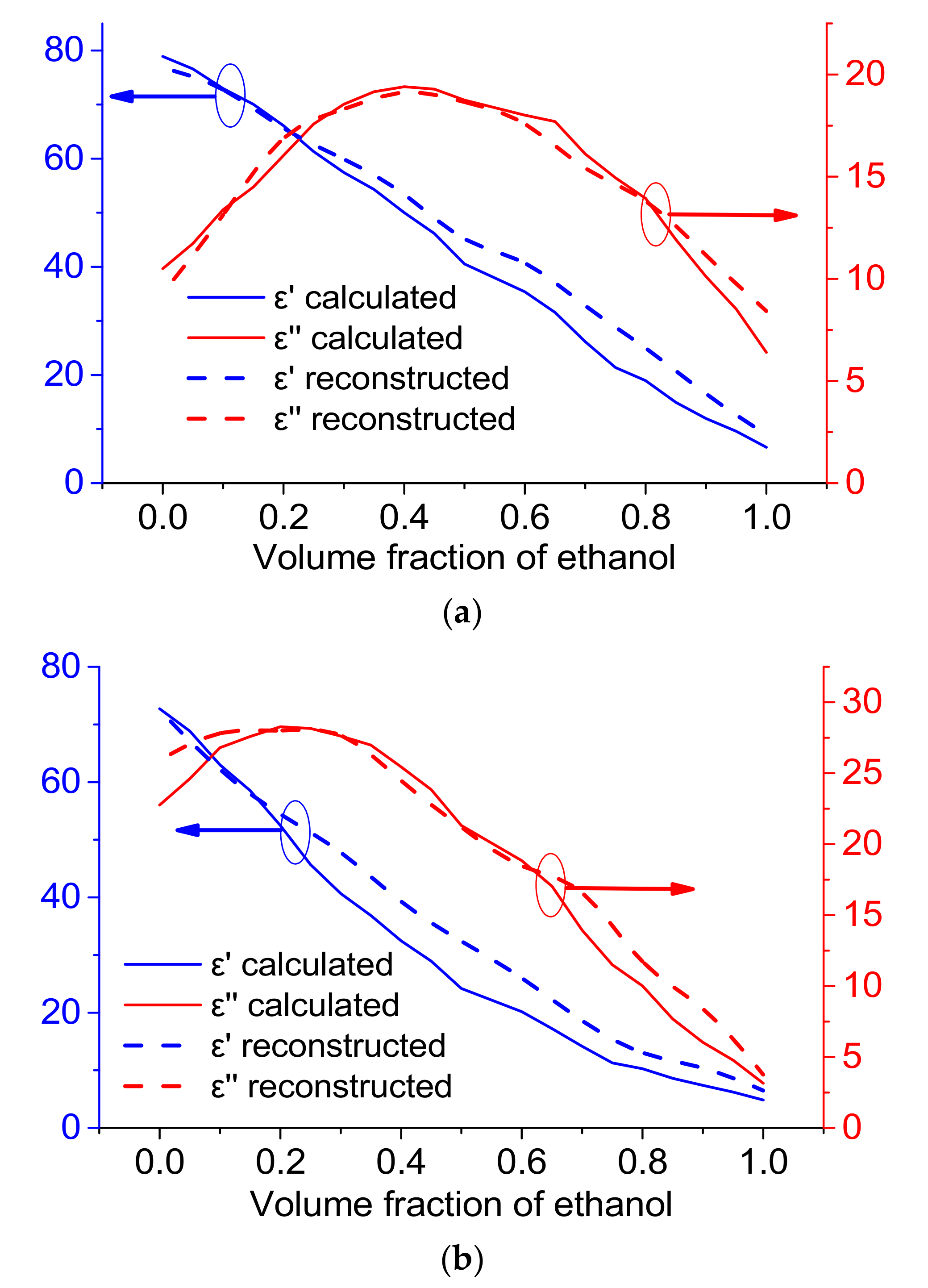
| Low Working Frequency | High Working Frequency | |||
|---|---|---|---|---|
| f0/GHz | Q | f0/GHz | Q | |
| Simulation | 2.4417 | 301.5 | 5.8415 | 324.3 |
| Measurement | 2.4414 | 319.2 | 5.8412 | 317.9 |
| Volume Fraction of Ethanol | 2.45 GHz | 5.85 GHz | ||||||
|---|---|---|---|---|---|---|---|---|
| ε′ Average | ε′ Standard Deviation | ε″ Average | ε″ Standard Deviation | ε′ Average | ε′ Standard Deviation | ε″ Average | ε″ Standard Deviation | |
| 0% | 77.34 | 1.91 | 10.38 | 1.47 | 72.52 | 1.99 | 23.31 | 1.65 |
| 10% | 71.60 | 1.65 | 13.23 | 0.95 | 61.62 | 1.73 | 27.49 | 1.56 |
| 20% | 64.83 | 1.84 | 16.21 | 1.25 | 53.11 | 1.56 | 27.84 | 1.47 |
| 30% | 56.52 | 1.56 | 18.35 | 1.40 | 41.46 | 1.65 | 28.26 | 1.65 |
| 40% | 50.90 | 1.92 | 19.59 | 1.56 | 33.04 | 1.47 | 24.81 | 1.32 |
| 50% | 41.20 | 1.39 | 18.64 | 1.22 | 24.71 | 1.39 | 21.22 | 1.47 |
| 60% | 36.09 | 1.25 | 17.79 | 1.32 | 20.68 | 1.13 | 18.40 | 1.32 |
| 70% | 26.67 | 1.48 | 15.92 | 1.04 | 14.44 | 1.30 | 14.31 | 1.18 |
| 80% | 19.25 | 1.35 | 14.12 | 0.87 | 10.48 | 1.14 | 10.27 | 1.08 |
| 90% | 12.10 | 1.04 | 10.23 | 0.36 | 7.55 | 0.96 | 6.16 | 0.98 |
| 100% | 6.76 | 0.87 | 6.47 | 0.44 | 4.96 | 0.87 | 3.23 | 0.78 |
Publisher’s Note: MDPI stays neutral with regard to jurisdictional claims in published maps and institutional affiliations. |
© 2022 by the authors. Licensee MDPI, Basel, Switzerland. This article is an open access article distributed under the terms and conditions of the Creative Commons Attribution (CC BY) license (https://creativecommons.org/licenses/by/4.0/).
Share and Cite
Chen, Q.; Long, Z.; Shinohara, N.; Liu, C. A Substrate Integrated Waveguide Resonator Sensor for Dual-Band Complex Permittivity Measurement. Processes 2022, 10, 708. https://doi.org/10.3390/pr10040708
Chen Q, Long Z, Shinohara N, Liu C. A Substrate Integrated Waveguide Resonator Sensor for Dual-Band Complex Permittivity Measurement. Processes. 2022; 10(4):708. https://doi.org/10.3390/pr10040708
Chicago/Turabian StyleChen, Qian, Zhuo Long, Naoki Shinohara, and Changjun Liu. 2022. "A Substrate Integrated Waveguide Resonator Sensor for Dual-Band Complex Permittivity Measurement" Processes 10, no. 4: 708. https://doi.org/10.3390/pr10040708
APA StyleChen, Q., Long, Z., Shinohara, N., & Liu, C. (2022). A Substrate Integrated Waveguide Resonator Sensor for Dual-Band Complex Permittivity Measurement. Processes, 10(4), 708. https://doi.org/10.3390/pr10040708







